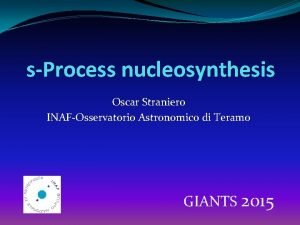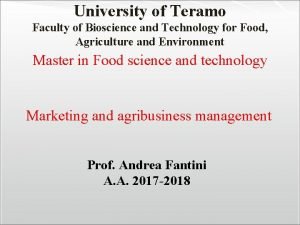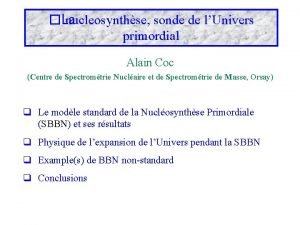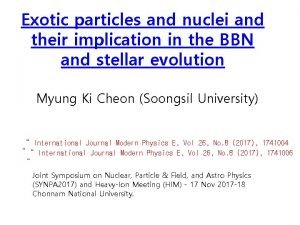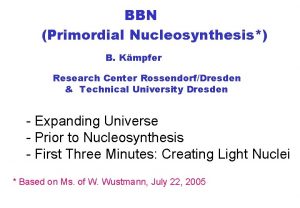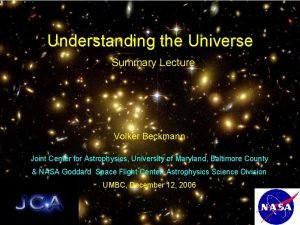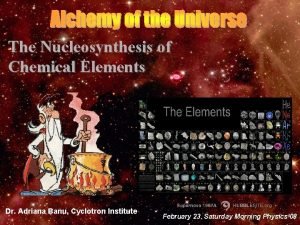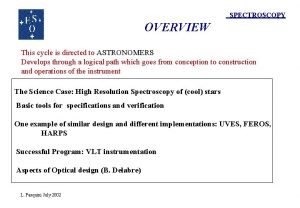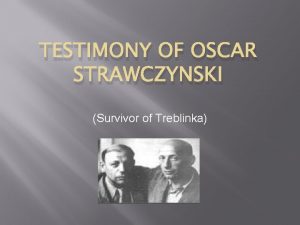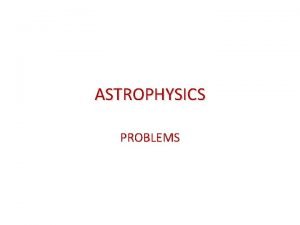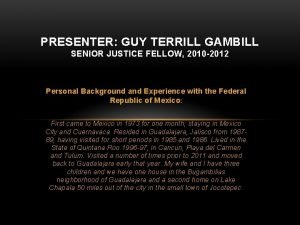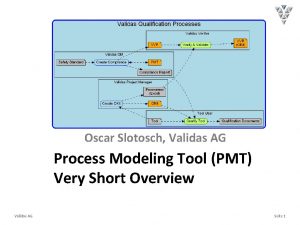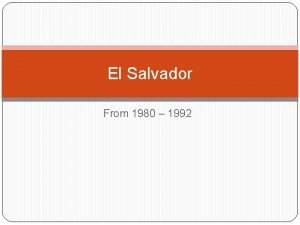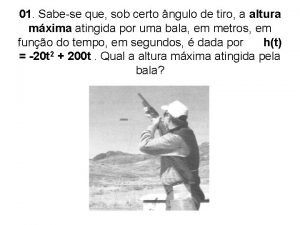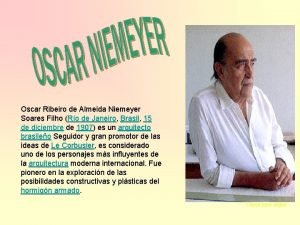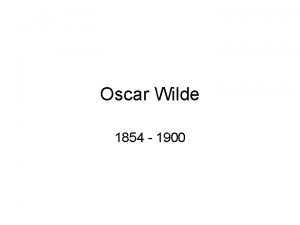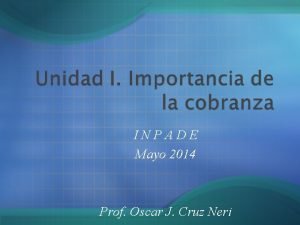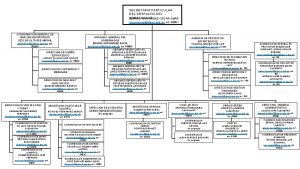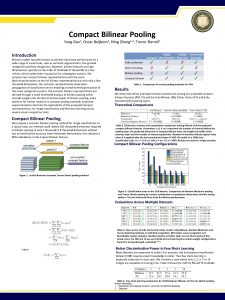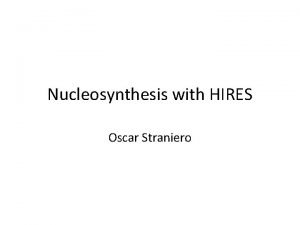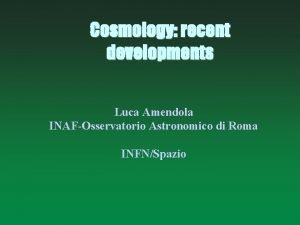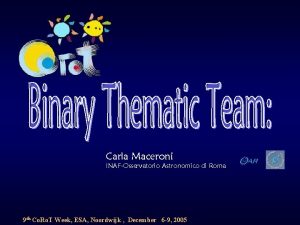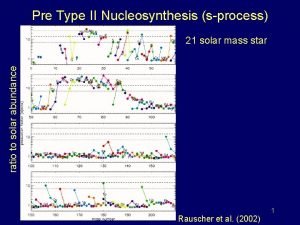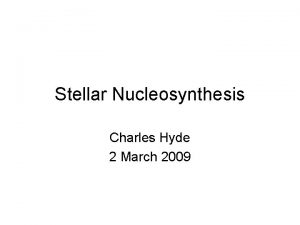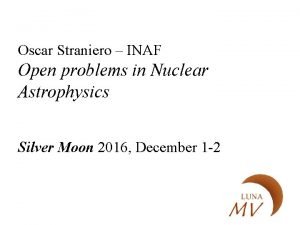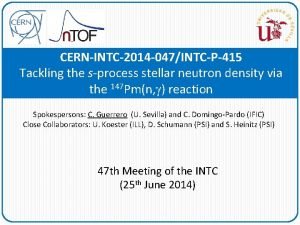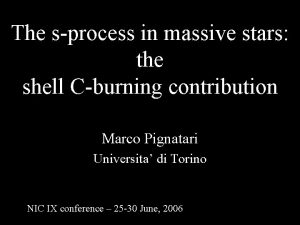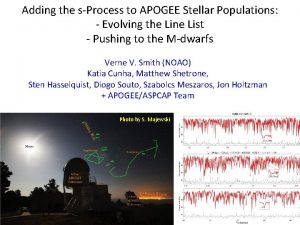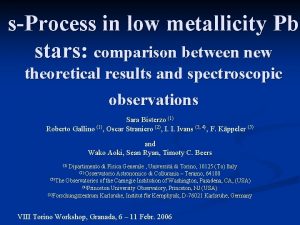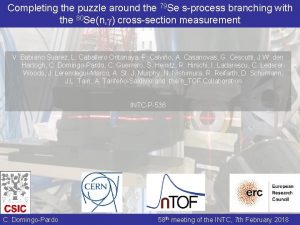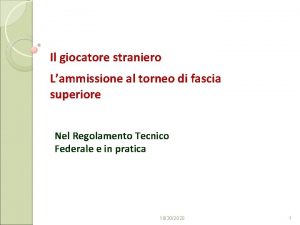sProcess nucleosynthesis Oscar Straniero INAFOsservatorio Astronomico di Teramo





































- Slides: 37

s-Process nucleosynthesis Oscar Straniero INAF-Osservatorio Astronomico di Teramo GIANTS 2015

s-process r-process Neutron Captures

s-only nuclei (& cosmo-chronometers)

500 isotopes (>1000 reaction rates) Z N

Maxwelian Average Cross Sections: KT=25 Ke. V Clayton 1968 Neutron Magic

main str weak on g 3 components: weak, main and strong Nʘ<s>

Where: �WEAK: MASSIVE STARS, M>10 Mʘ Core-He burning (late part), shell-C burning. �MAIN: LOW MASS TP-AGB STARS, 1. 2<M/Mʘ<3 Thin pocket close to the top of the He-rich mantel, during the interpulse period (time elapsed between two Thermal Pulses). �STRONG: LOW MASS & LOW Z TP-AGB STARS same site as for the main component �Other s-process site (marginal contribution to Ch. Ev. ): q Intermediate mass AGB stars (3<M/Mʘ<5 ) in convective zone powered by a thermal pulse. q EMP AGB or VLTP stars undergoing proton ingestions during TPs. q SNe Type Ia progenitors (? ? ).

Neutron density, neutron exposure, stellar timescale 88 Sr T KT Vth MACS <s. V> tstellar nn K erg cm/sec cm 2 cm 3/s yr 1/cm 3 AGB radiative 13 C 1. 00 E+08 1. 38 E-08 1. 29 E+08 1. 10 E-26 1. 41 E-18 1. 00 E+04 2. 36 E+06 AGB conv. 22 Ne 3. 50 E+08 4. 83 E-08 2. 41 E+08 6. 00 E-27 1. 44 E-18 1. 00 E+00 Core-He burning 2. 00 E+08 2. 76 E-08 1. 82 E+08 8. 00 E-27 1. 45 E-18 1. 00 E+06 2. 29 E+04 Shell-C burning 1. 00 E+09 1. 38 E-07 4. 07 E+08 3. 00 E-27 1. 22 E-18 1. 00 E+00 2. 73 E+10 2. 31 E+10

Branches and Bottlenecks

Which conditions: 1 Temperature (108 K) 3 15 Thermal Energy (Ke. V) 120 shell-C burning core-He burning 30 AGB 22 Ne conv. AGB 13 C radiative 8

Neutrons Sources: WEAK : 22 Ne(a, n)25 Mg n=105 -106 cm-3 (core-He burning) n=1011 -1012 cm-3 (shell-C burning) additional n sources (? ): 17 O(a, n)20 Ne 12 C(12 C, n)23 Na MAIN and STRONG: 13 C(a, n)16 O n=106 -107 cm-3 22 Ne(a, n)25 Mg n=1010 -1013 cm-3 (low-mass AGB; interpulse period) (AGB; convective pulse)

Modelling AGB stars and their nucleosynthesis The s-process paradigm after Straniero et al. 1995 ; Gallino et al. 1998 13 C( a, n)16 O 22 Ne( a, n)25 Mg

• in low-mass AGB stars (1. 5 -2. 5). s process controlled by the 13 C(a, n)16 O operating in a thin pocket (10 -3 M ) during the interpulse: ʘ T=90 MK (8 Ke. V), timescale=105 yr neutron density = 107 cm-3 neutron exposure=0. 4 mbarn-1 neutrons/seeds=from 1 (solar Z) up to >20 (at low Z) • In massive AGB (M>4) the s process is dominated by the 22 Ne(a, n)25 Mg operating at the base of the convective zone generated by a TP: T>300 MK (30 Ke. V), timescale<1 yr neutron density >1011 cm-3 (up to 1013) neutron exposure<0. 1 mbarn-1 neutrons/seeds < 10

The 3 players of the s-process neutrons poisons seeds Cameron (1957) Ratios of the 3 s-process peaks ls, hs, Pb

Variations of metallicty (seeds) 0. 0001<Z<Z FUNS results Cristallo et al. 2009 & 2011 Pb, Bi hs=Ba, La, Nd ls=Y, Sr, Zr

AGB nucleosynthesis is a complex interplay of several phenomena, among which convection and nuclear burning are, perhaps, the most important. Interferences may be constructive or destructive, so that the resulting nucleosynthesis may be enhanced or suppressed.

The "bagnasciuga" (wet & dry) The s-process problem, i. e. , how to model the transition zone between the sea and the shore (where children play).

No compositiondredge variations up Convective layer stable radiative layer Transition layer Hydrodynamical models of overshoot: convective He H radiative 1) the penetration increases as the stability of the radiative layer below the convective zone decreases , e. g. Singh 1995 2) The velocity decays exponentially, e. g. Freytag 1996 from Straniero et al. 2006

Why an exponential decay of V? Viscous dissipation of kinetic energy -> 2. 5 v/vo ; r/a 2 1. 5 1 0. 5 0 0 2 4 time/avo 6 8 10

The formation of the 13 C pocket in the "wet&dry" transition zone M=2 M Z=Z a) Maximum envelope penetration (during TDU); b) 12 C(p, )13 N(β-)13 C 13 C(p, )14 N c) reactions; and 22 Ne(p, )23 Na; d) After about 1000 yr since a).

From post-pocess to a more realistic description of the AGB nucleosynthesis In low mass star, s-process dominated by the first few 13 C neutron burst episodes. After 4 -5 TPs, hs/ls and Pb/hs frozen in the He rich zone.

The extension of the 13 C pocket decreases as the Mass Increase. • It implies: less efficient 13 C neutron source as the stellar mass increases 1. 1. 5<M<3 Similar Core Mass <-> Similar 13 C pockets 3<M<5 Progressive reduction of the 13 C pockets M>5 Negligible 13 C pockets 1 Mass limits depend on Z and Y [Fe/H]=-1. 7

Additional processes…. • Instabilities induced by Rotation may modify the H profile left by the third dredge up and, later on, the 13 C and the 14 N profile into the pocket (Piersanti et al. 2013). • The bulk motion in the convective envelope generates gravity waves propagating inward. Turbulence may be generated by non-linear effects (Denussenkov 2003) or by interaction with rotation (Talon 2007). The consequent mixing may affect nucleosynthesis and angular momentum transport • Magnetic field dissipates angular momentum (magnetic breaking, Sujis 2008), but may also induce magnetic buoyancy operating in the He-rich intershell (Trippella this meeting).

Differential Rotation: ES + GSF instabilities during the interpulse Sharp variations of w and j left by the TDU drives GSF Meridional Circulation is always active in rotating stars, because of the von Zeipel effect, but it is inhibited by a m gradient. See, e. g. Langer et al. 1999, Siess et al. 2004, Herwig et al. 2003, Piersanti et al. 2013

Development of rotation-induced instabilities between the 2 nd and the 3 rd TDU (M=2 Mʘ [Fe/H]=0) \ convection ||| X(13 C)>10 -3 ES GSF

The rotation paradigm + Turbulent convection at TDU: a proton profile forms at the top of the He-rich zone AS a result: lower Rotation induced instabilities during the interpulse: redistribution of protons and, later on, of 13 C -14 N on a larger area. Same neutrons, more seeds and more poisons

from Piersanti et al. 2013

Are theoretical calculattions reliable? Convective and other mixing (e. g. those induced by rotation). l Mass loss l Reaction rates l In the rest of the lecture: Influence of 22 Ne(a, n)25 Mg & 13 C(a, n)16 O on the s-process nucleosynthesis.

(Whiescher-Jager)/Jager 22 Ne(a, n)25 Mg AGB: convective thermal pulse Mass. Stars: Core-He burning T (1 E 9) Jager et al. 2001, Karakas et al. 2006, Iliadis et al. 2011

85 Kr branching and Rb abundance Jager et al. 2001 22 Ne(a, n)25 Mg x 2 13 C(a, n)16 O dominated 22 Ne(a, n)25 Mg dominated

s-rich stars in Globular Clusters: the transition between 13 C and 22 Ne 13 C+22 Ne from Straniero et al. 2014

High Z: 13 C pocket is not fully consumed during the interpulse. 13 C engulfed in to the pulse driven convective zone. 13 C convective burning

Residuals before radiative Residuals in the 1313 engulfment 16 O +30% burning 13 C 16 C(a, n) O -30% TP convective zone 14 N 13 C Drottleff et al. 1993; heil et al. 2008 (± 30% at T 6=100)

CONVECTIVE 13 C burning 60 Fe production Convective 13 C(α, n)16 O 22 Ne(α, n)25 Mg t=0 at the 13 C-pocket ingestion in the convective shell


Changing the neutron sources: effect on 60 Fe M=3 M Z=Z log X(60 Fe) +30%

Summary: Effects on the bulk of the s process: 22 Ne rate, intermediate mass only → light-s excess. Depends on metallicity. l Branches: e. g. , 86 Kr, 87 Rb or 96 Zr are affected by the 22 Ne rate. Similar effects by changing the 13 C rate, if 13 C survives after the radiative burning. Several observational counterparts l Radioactive isotopes: both neutron sources affect the 60 Fe production. An increase of the 22 Ne rate would also reduce the 26 Al. l
 Oscar straniero
Oscar straniero University of teramo
University of teramo Primordial nucleosynthesis
Primordial nucleosynthesis Exotic nucleosynthesis
Exotic nucleosynthesis Primordial nucleosynthesis
Primordial nucleosynthesis Primordial nucleosynthesis
Primordial nucleosynthesis Becquerel
Becquerel Main sequence fitting
Main sequence fitting Oscar strawczynski
Oscar strawczynski Oscar properties problem
Oscar properties problem Bowling for columbine transcript
Bowling for columbine transcript óscar osvaldo garcía montoya
óscar osvaldo garcía montoya The good always wins over evil the selfish giant
The good always wins over evil the selfish giant Oscar diaz pilates
Oscar diaz pilates Oscar piedrahita
Oscar piedrahita Validas
Validas Oscar wilde zanichelli
Oscar wilde zanichelli Dorian grey effect
Dorian grey effect Oscar torres el salvador
Oscar torres el salvador Sabe-se que sob certo angulo de lançamento a altura h
Sabe-se que sob certo angulo de lançamento a altura h Oscar rational consumer
Oscar rational consumer Oscar ribeiro de almeida niemeyer soares filho
Oscar ribeiro de almeida niemeyer soares filho Oscar wilde dandy
Oscar wilde dandy Oscar masan
Oscar masan Metanormer
Metanormer Oscar bernaldez
Oscar bernaldez Oscar fredriksskolan
Oscar fredriksskolan Classify the food items in exercise 1 countable nouns
Classify the food items in exercise 1 countable nouns Oscar ramudo home office
Oscar ramudo home office Miss laetitia prism
Miss laetitia prism Oscar rizzo
Oscar rizzo Oscar fuentes lira
Oscar fuentes lira Oscar bulla celia cruz
Oscar bulla celia cruz Katawagan sa pag-aaral ng pinakamaliit na yunit ng salita
Katawagan sa pag-aaral ng pinakamaliit na yunit ng salita Daniel guzman nuñez
Daniel guzman nuñez Dandy aesthetic movement
Dandy aesthetic movement Summary of chapter the selfish giant
Summary of chapter the selfish giant Oscar beijbom
Oscar beijbom
